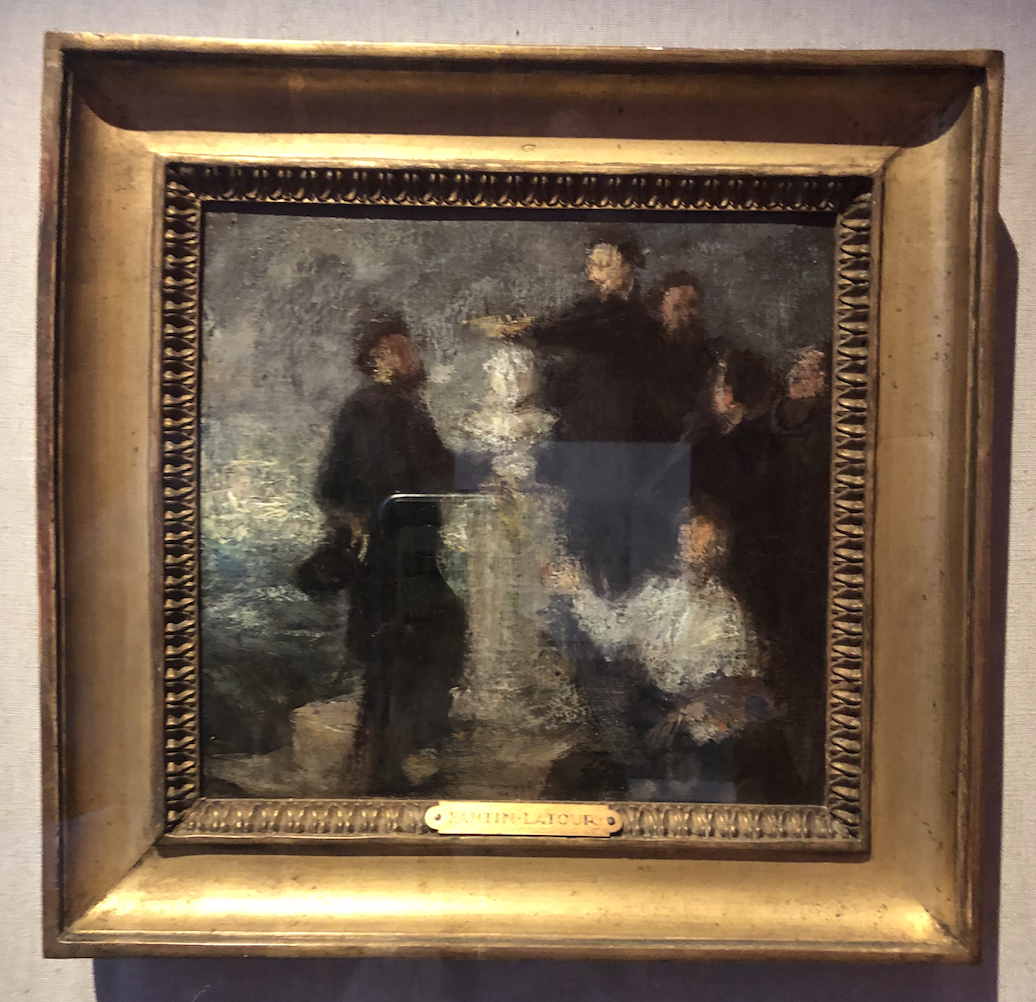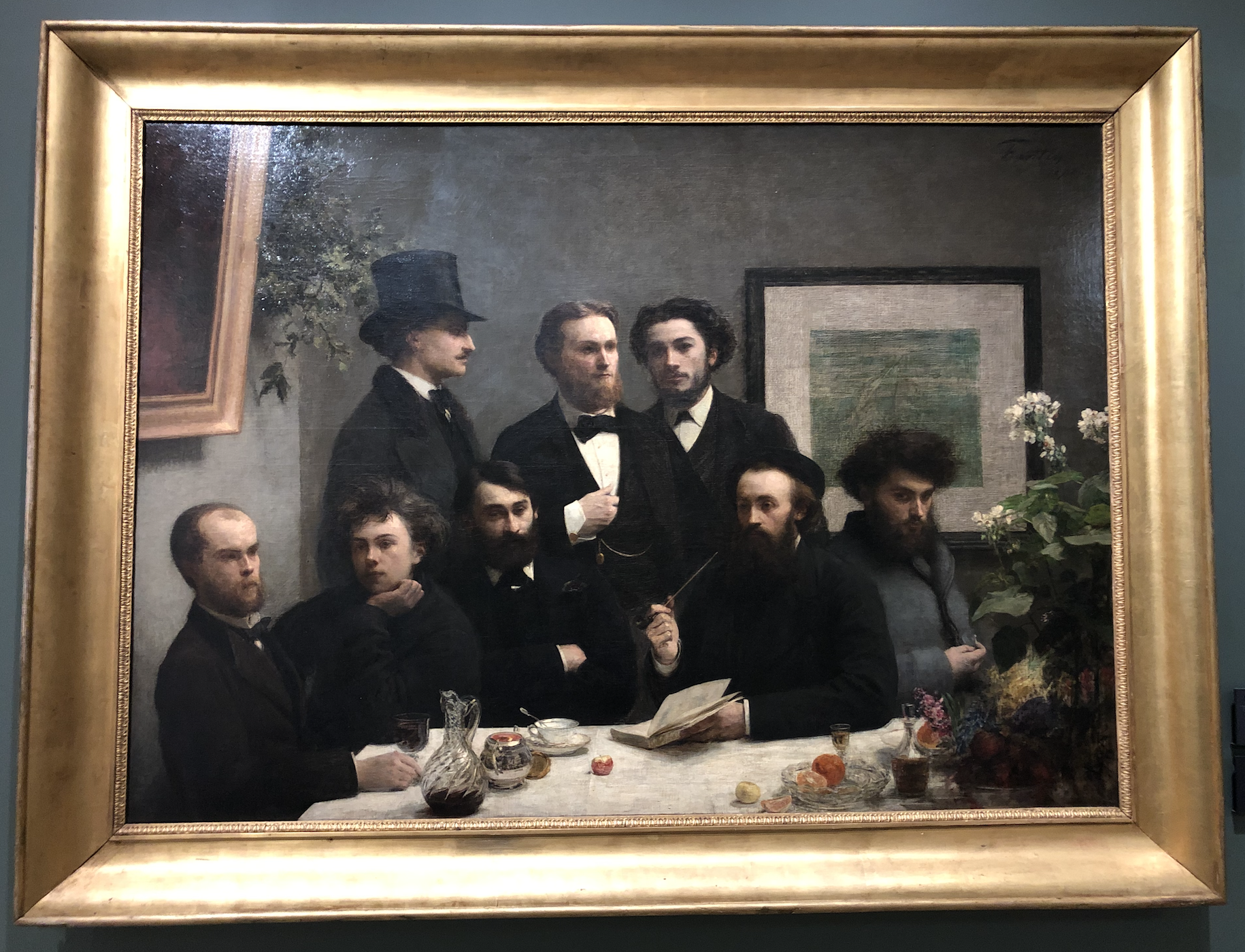Henri Fantin-Latour is known by many for his beautiful still lifes of flowers and his group paintings. Born in Grenoble on January 14, 1836, he studied art from his father Theodore Fantin-Latour who worked in pastels. In 1850 young Henri moved to Paris and enrolled at the Petite Ecole de Dessin de Paris then the Ecole des Beaux-Arts in Paris in 1854 where he met Degas, Whistler, and Legros. Fantin-Latour also spent a few months in the studio of Gustave Courbet at 53 Rue Notre Dame des Champs on the edge of the Jardin du Luxembourg.
Henri first honed his skills with numerous charcoal, oil, and chalk self-portraits. Whistler encouraged him to visit London and also learned to engrave from Edwin Edwards. His still-life paintings of flowers were highly regarded especially among London customers which was an early way for him to make a nice living.
In 1873 he met fellow artist Victoria Dubourg in the Musée du Louvre where most women had to train with a chaperone of course. They married three years later and collaborated on many floral paintings. Some of my favorite paintings by Fantin-Latour are his group paintings.
I love a painting that holds a story that can be uncovered and group paintings, holy moly, it’s a dream. Fantin-Latour created four between 1864 and 1885 and all are held in the Musée d’Orsay. A few are visiting Abu Dabi at the moment but they will be back soon.
The first was done in 1864 and was created in response to the lack of attention my beloved Eugene Delacroix received after his death. The Romantic master’s funeral was held on August 17, 1863, in the Eglise Saint Germain des Prés. Henri, Manet, Whistler, Zola, Pissarro, Degas, and Baudelaire were all in attendance. Still, they were shocked that the man that influenced a generation of Impressionists and reinvent color had such a small turnout for his final moments. It was August after all and the Parisian went on vacation, but it was Delacroix! Fantin-Latour watched as the funeral undertakers tossed aside Delacroix’s Institut de France academic robes in disgust.
Fantin-Latour would paint a masterpiece dedicated to his friend and bring him the recognition he deserved. In Homage à Delacroix a painting of Delacroix takes center stage surrounded by friends and admirers.
Seated from left to right we see art critic and writer Louis Edmond Duranty, Fantin-Latour in a white shirt, writer Jules Champfleury and on the lower right Charles Baudelaire who was always a supporter of Delacroix. Standing left to right is Louis Cordier, art school friend Alphonse Legros and to the left of the painting of Delacroix, James Abbot McNeill Whistler, the American-born artist who arrived in Paris in 1855. At the other edge of the frame is the wonderful Édouard Manet who needs no introduction at all, and we round out with artist Felix Bracquemond who was a bit of a jerk and artist Albert de Balleroy.
The painting was first displayed at the 1864 Salon to raving reviews. Purchased at the Salon by Ernest Gambart it would end up in the great collection of Etienne Moreau-Nealton which I will go into great detail about soon. Upon his death in 1906, it was given to the Louvre which would pass it to the Orsay in 1986.
In 1870 Fantin-Latour painted Un Atelier aux Batignolles and brought together his friends in one painting centered around Manet’s atelier in Batignolles. The norm-pushing Édouard Manet sits at the easel most likely painting a naked lady that will flip the stodgy art world leaders out. Standing to his right is artist Otto Scholderer and just behind him is Pierre Auguste Renoir. Not such a bad group of guys. Next to Renoir is Émile Zola, Manet’s biggest champion, Edmond Maitre a musician and the tall chap is Drédéric Bazille, an artist that lived in the studio of Delacroix after his death with the chap in the corner, Claude Monet. Seated to Manet’s left is Zacharie Astruc, an artist that also created that fantastic sculpture of the mask seller in Jardin du Luxembourg I shared a few weeks ago. So good right?! And we have two more to go.
1872 was the writer’s turn in Coin de Table. Originally it was an idea to create a painting dedicated to Baudelaire for his 50th birthday but musician Edmond Maitre recommended they use the writers that gathered in the Place Saint Sulpice monthly, all of whom Maitre knew and could ask them to sit for him.
Starting from left to right is Paul Verlaine and looking longingly at him is his lover Arthur Rimbaud this was painted a year into their relationship. Next to Arthur is poet and playwright Léon Valade, writer Ernest d’Hervilly and hiding in the corner Camille Pelletan a historian and journalist. Standing above in the top hat is poet Pierre Elzéar, Émile Blémont, and Jean Aicard all poets as well. Baudelaire may not be here but the flowers on the table are a nod to his most famous work, Fleur du Mal.
The last piece was done much later in 1885 and dedicated to a group of musicians known as “Le Petit Bayreuth”. Seated at the piano is Emmanuel Chabrier, and next to him, are close friends Edmond Maitre and Amédée Pigeon. Standing left to right is Adolph Julien, Arthur Boisseau, Camille Benoit, Antoine Lascouc, and Vincent d’Indy with the fancy mustache. Each of the men was a composer and musician and devotee of Wagner and was part of the Wagnerists group.
Of the four, the two are my favorite, anything with Delacroix and Manet will do that.
For another fun, group check out Maurice Denis’ Hommage à Cezanne also in the Orsay






